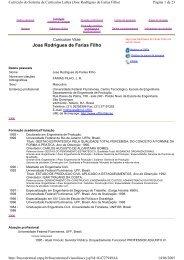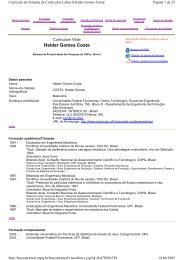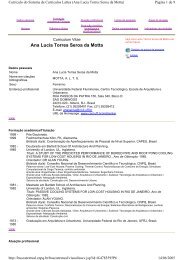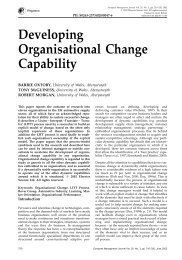e-Marketplaces: Crafting A Winning Strategy - Latec
e-Marketplaces: Crafting A Winning Strategy - Latec
e-Marketplaces: Crafting A Winning Strategy - Latec
Create successful ePaper yourself
Turn your PDF publications into a flip-book with our unique Google optimized e-Paper software.
Pergamon<br />
PII: S0263-2373(02)00045-2<br />
European Management Journal Vol. 20, No. 3, pp. 286–298, 2002<br />
© 2002 Elsevier Science Ltd. All rights reserved.<br />
Printed in Great Britain<br />
0263-2373/02 $22.00 + 0.00<br />
e-<strong>Marketplaces</strong>:<br />
<strong>Crafting</strong> A <strong>Winning</strong><br />
<strong>Strategy</strong><br />
PETER BRUNN, Technical University of Denmark, Denmark<br />
MARTIN JENSEN, Boston Consulting Group, Denmark<br />
JAKOB SKOVGAARD, McKinsey and Co., Denmark<br />
Very little theoretical work has been done that truly<br />
helps e-marketplace managers understand and craft<br />
strategy. To help fill this gap the Temple Framework,<br />
which is introduced in this article, has been<br />
developed. This theoretical framework explains<br />
how e-marketplaces, in order to achieve success,<br />
must create a powerful setup (thus creating a strong<br />
strategic position) and meet the challenge of building<br />
liquidity and capturing value. It also suggests<br />
ways to meet this challenge as well as it explains<br />
the considerations that must go into designing each<br />
element of the setup.<br />
The Temple Framework has been extensively tested<br />
during the roll out of gatetrade.net, an ambitious e-<br />
marketplace founded by influential Danish companies<br />
with a European and international presence. In<br />
this article, gatetrade.net provides valuable insights<br />
on some of the lessons learned while working with<br />
the Temple Framework. © 2002 Elsevier Science<br />
Ltd. All rights reserved.<br />
Keywords: e-Marketplace, Liquidity, Business<br />
Model, Temple Framework, Revenue Model, Collaboration,<br />
Business-to-Business, e-Commerce, e-<br />
Business<br />
Introduction<br />
Lately there have been many articles in business periodicals<br />
and financial newspapers about e-commerce<br />
and the new e-marketplaces that have started to pop<br />
up. Strategies of value creation in e-commerce have<br />
also been dealt with in this journal (e.g. Zott et al.,<br />
2000) focusing on efficiency and ‘stickiness’ of e-commerce<br />
business models and illustrating this by ‘best<br />
practices’ in Europe. e-<strong>Marketplaces</strong> can be said to<br />
represent a second wave in the e-commerce propa-<br />
gation and extending the Business and Consumer<br />
combinations (B2C, C2B and C2C) into the prosperous<br />
Business-to-Business (B2B) area. In our understanding<br />
e-marketplaces can be defined as interactive<br />
business communities providing a central market<br />
space where multiple companies can engage in B2B<br />
e-commerce and/or other e-business activities<br />
(Jensen and Skovgaard, 2001).<br />
A few years back only a small percentage of these e-<br />
marketplaces existed, but now the rapidly increasing<br />
adoption of the Internet by companies world-wide<br />
has changed everything. The explosive increase in<br />
reach and the significant decrease in transaction costs<br />
that have followed in the wake of the Internet penetration<br />
have made the e-marketplace business<br />
model feasible and attractive. As a consequence we<br />
have seen the establishment of quite a few e-marketplaces<br />
in various settings, public as well as private.<br />
During the few years they have been around we have<br />
witnessed both successes and failures among the e-<br />
marketplaces. However, the failures far outnumber<br />
the successes. A general experience seems to have<br />
been that it is very difficult to establish as a public<br />
e-marketplace. Examples are Chemdex, Dell Marketplace<br />
and Junebox. Typically the public e-marketplace<br />
has high initial investments and also high operational<br />
costs, which can only be covered by a<br />
substantial, often unrealistic, market share. Adding<br />
to the difficulties may also be that the e-marketplaces<br />
have required their users to change their way of<br />
doing business, which is at best a slow process. One<br />
reason for this may be that buyers and sellers have<br />
in fact not been ready to change their way of doing<br />
business. Furthermore, participating in a public e-<br />
marketplace often means having to accept being outside<br />
the control of the e-marketplace. Together these<br />
286<br />
European Management Journal Vol. 20, No. 3, pp. 286–298, June 2002
E-MARKETPLACES: CRAFTING A WINNING STRATEGY<br />
circumstances have caused the failure of many public<br />
e-marketplace initiatives.<br />
In contrast, private e-marketplaces seem to have been<br />
more successful, e.g. Cisco Connection. A possible<br />
explanation is that in contrast to the public model it is<br />
the e-marketplace that must change the way of doing<br />
business. Another factor may be that integration<br />
issues regarding existing ERP systems tend to be simpler<br />
to solve for private e-marketplaces – a fact which<br />
was often not appreciated fully by many of the failing<br />
public e-marketplaces.<br />
A general lesson seems to be that investments to create<br />
e-marketplaces are very high, and that the technology<br />
is often not mature. Many e-marketplaces<br />
built during the past few years have been founded<br />
on optimism and hope rather than on attractive value<br />
propositions and solid strategies. We therefore see a<br />
need for taking a closer look at what considerations<br />
should go into crafting a strategy for an e-marketplace.<br />
A Holistic Approach<br />
Due to the recent conception of the e-marketplace<br />
business model there has been relatively little<br />
research conducted on the topic so far. Furthermore,<br />
most of the research that has been conducted has<br />
applied very specific viewpoints (e.g. looking at e-<br />
marketplaces from a technological viewpoint, as an<br />
investment opportunity, or from the viewpoint of a<br />
specific industry or a specific geographic market).<br />
Little research has been conducted aiming at<br />
developing models that can aid e-marketplace managers<br />
in understanding the e-marketplace business<br />
model and crafting strategy by providing a holistic<br />
viewpoint.<br />
For this reason the goal of our study on e-marketplaces<br />
has been to develop and test a holistic theoretical<br />
framework for e-marketplace strategy that can<br />
help bridge the gap between existing but fragmented<br />
theory and the needs of e-marketplace managers. By<br />
this we hope to cast light on the question highest on<br />
the agenda of e-marketplace managers: how to craft<br />
a winning e-marketplace strategy?<br />
Understanding e-<strong>Marketplaces</strong><br />
<strong>Crafting</strong> a winning e-marketplace strategy starts with<br />
an understanding of the e-marketplace business<br />
model. Without a deep understanding of how e-marketplaces<br />
create value the chances of crafting a strategy<br />
that will lead to sustainable competitive advantage<br />
are slim.<br />
The core service of e-marketplaces is to provide a<br />
central market space, where e-commerce can be conducted.<br />
However, although e-commerce is a very<br />
important aspect of e-marketplaces, it is important to<br />
understand that e-marketplaces are not limited to<br />
facilitate e-commerce, nor is e-commerce necessarily<br />
the most important aspect of a given e-marketplace.<br />
Other e-business activities that are just as valuable<br />
for the participants often take place (see Figure 1).<br />
For example, e-marketplaces can extend e-commerce<br />
with the functionality of electronic catalogues and<br />
auctions and by providing order fulfilment services<br />
such as tracing, financing and logistics. Another<br />
possibility is for the e-marketplace to play the role<br />
of organiser of various forms of collaboration for the<br />
participants of the e-marketplace, e.g. demand forecasting<br />
and inventory management.<br />
These types of activities allow e-marketplaces to<br />
build their value proposition upon three fundamental<br />
elements. In order of rising complexity they are<br />
(1) increased market efficiencies, (2) increased supply<br />
chain efficiencies, and (3) new value creation.<br />
With respect to market efficiency it is a fact that few<br />
real markets are truly efficient as predicted by<br />
microeconomic theory. Opaqueness, large transaction<br />
costs, regulation etc. are all conditions that make the<br />
real-life situation look a whole lot different than the<br />
theory. e-<strong>Marketplaces</strong> have the potential to make<br />
real-life work more like theory predicts, as they can<br />
significantly increase market efficiency. The intensified<br />
competition and the increased transparency of<br />
the Internet go hand in hand with the emergence of<br />
e-marketplaces and push prices closer to the theoretical<br />
equilibrium. This is because the e-marketplaces<br />
facilitate a way to increase transparency and bring<br />
together buyers and sellers and match their needs at<br />
much lower costs than before. Also supply chains have<br />
a vast potential for better efficiency. For the purpose<br />
of optimising business processes across supply<br />
chains, Supply Chain Management (SCM) has been<br />
studied and practised intensely in the 1990s. Successful<br />
e-marketplaces build on the same thoughts as<br />
they bring a standard for collaboration and interaction<br />
between companies. By providing users with<br />
good collaboration tools such as demand forecasting,<br />
inventory management and production planning, e-<br />
marketplaces help provide increased visibility across<br />
several tiers of the supply chain. Furthermore,<br />
because the way to collaborate is standardised, e-<br />
marketplaces also allow for a much more dynamic<br />
choice of sourcing partners (Means and Schneider,<br />
2000). In essence e-marketplaces are positioned to<br />
bring a new era of synchronised supply chains that<br />
are dynamic and therefore can be continuously<br />
improved. On top of the increased efficiencies in the<br />
market, and in the supply chain, e-marketplaces also<br />
bring fundamental changes to the way business is<br />
conducted in the B2B market space. Hence numerous<br />
opportunities on how to create value-adding activities<br />
exist (Berryman et al., 2000) – many of them as yet<br />
unexplored. The foundation for innovative services<br />
creating new value is information. The vast amount<br />
of information about product offerings and trans-<br />
European Management Journal Vol. 20, No. 3, pp. 286–298, June 2002 287
E-MARKETPLACES: CRAFTING A WINNING STRATEGY<br />
Figure 1<br />
The e-Marketplace Business Model<br />
actions of the participating companies now available<br />
from one single source becomes more transparent.<br />
Building on that information base new value can be<br />
created by bringing more radical and transformational<br />
changes to the supply chain yielding<br />
efficiency at a level not at all possible before the<br />
emergence of e-marketplaces. Furthermore, value can<br />
be created from new ideas having a fundamental<br />
impact on the business scope of both the e-marketplaces<br />
themselves and the participating companies.<br />
These observations regarding the value creation of<br />
e-marketplaces apply broadly to all e-marketplaces.<br />
However, it is useful to distinguish between two<br />
types of e-marketplaces: horizontal e-marketplaces<br />
and vertical e-marketplaces. The horizontal e-marketplaces<br />
are based on functions and/or products common<br />
across industries (i.e. the operating input), while<br />
the vertical e-marketplaces are those that are based<br />
on a specific industry tied together by the manufacturing<br />
input. The core value proposition of horizontal<br />
e-marketplaces is usually that of lower transaction<br />
costs in the purchasing process while a lower price<br />
is also often the result for buyers. However, because<br />
of the diversity of customers it is hard for horizontal<br />
e-marketplaces to introduce effective collaborative<br />
tools with an effect on overall supply chain efficiency.<br />
In contrast facilitation of collaboration is usually the<br />
core value proposition of vertical e-marketplaces as<br />
they are well positioned to cater for special needs,<br />
wants and customs attached to each industry.<br />
The Temple Framework<br />
Understanding the basics of the e-marketplace business<br />
model however, is not enough. For e-marketplace<br />
managers the question remains: how to craft a<br />
winning strategy?<br />
To provide managers with an overall perspective on<br />
e-marketplace strategy we have developed a comprehensive<br />
framework (see Figure 2) called the Temple<br />
Framework. It identifies the main challenge of achieving<br />
e-marketplace success (building liquidity and<br />
capturing value), provides detailed analysis of this<br />
challenge, and suggests ways by which it can be<br />
overcome. Furthermore, it identifies and clearly<br />
explains the considerations that should go into deciding<br />
how to set up the strategy of an e-marketplace,<br />
and the implications.<br />
The theoretical background for this framework is our<br />
synthesis of contemporary research and literature on<br />
the topic of e-marketplaces (mainly the works of<br />
Sculley and Woods, 2000; Ramsdell, 2000; Means and<br />
Schneider, 2000; Skinner, 2000; Goolsbee, 2000 and<br />
Andrew et al., 2000).<br />
Empirically, the Temple Framework is supported<br />
broadly by numerous observations and examples<br />
from existing e-marketplaces as well as by the sparse<br />
statistical material part of the works mentioned<br />
above. Most noticeably however, the empirical inputs<br />
to our research originate from an in-depth case study<br />
conducted with the Danish e-marketplace gatetrade.net.<br />
The case study at gatetrade.net has enabled<br />
us to refine the framework as well as to validate its<br />
value to e-marketplace managers.<br />
The Temple Framework has three main parts, as<br />
illustrated in: The Objective, The Challenge, and The<br />
Setup. While the objective is largely self-explanatory,<br />
the setup and challenge parts and their elements<br />
require a more detailed and thorough description,<br />
which is given in the following sections. However,<br />
before going into detail a few pointers on our intention<br />
with the Temple Framework are appropriate.<br />
First of all, it is important to understand that the<br />
Temple Framework is based on one central hypothesis<br />
that clearly describes how the framework should<br />
be interpreted: In order to achieve the objective of e-<br />
marketplace success one must create a powerful setup<br />
(thus creating a strong strategic position) and meet<br />
the challenge of building liquidity and capturing<br />
value. Second, it should be noted that the Temple<br />
Framework refers to e-marketplace success as seen<br />
strictly from the perspective of the e-marketplace as<br />
an independent entity, i.e. an e-marketplace is successful<br />
only if it is profitable. This is important, as<br />
incumbents that launch a private e-marketplace or<br />
take equity in a public e-marketplace are likely to<br />
define the initiative as a success as long as it provides<br />
them with significant value (for example defending<br />
288<br />
European Management Journal Vol. 20, No. 3, pp. 286–298, June 2002
E-MARKETPLACES: CRAFTING A WINNING STRATEGY<br />
Figure 2<br />
The Temple Framework<br />
market share or through cost savings), even if the e-<br />
marketplace itself does not make a profit. By having<br />
defined success in this way we wish to make it clear<br />
that the primary concern of the Temple Framework<br />
is public e-marketplaces. However, the Temple<br />
Framework is also valuable for private e-marketplaces,<br />
as it is useful for understanding and analysing<br />
their strategic issues as long as their special traits are<br />
kept in mind when using the framework. Third, with<br />
respect to the word ‘setup’ it should be stressed that<br />
nothing static is implied. The setup is actually of a<br />
rather dynamic nature, as it is our hypothesis that<br />
the setup of an e-marketplace should be changed continuously<br />
as the environment of the e-marketplace<br />
changes and the e-marketplace grows and matures.<br />
This is equivalent to how strategy and business plans<br />
should be revised as conditions change. Fourth, the<br />
framework describes building liquidity and capturing<br />
value as the challenge. This is to illustrate that<br />
although there are two elements they need to be considered<br />
together due to their tight linkage. That is, e-<br />
marketplaces must always keep in mind that<br />
decisions on how to capture value influence the<br />
building of liquidity – and the other way around.<br />
Lastly, it should be made clear that because most e-<br />
marketplaces are still in their infancy, the discussion<br />
(of both the setup and the challenge) below emphasises<br />
the issues related to getting the e-marketplace<br />
off the ground, while less attention has been given<br />
to issues concerned with the later phases in the life<br />
of e-marketplaces.<br />
The Setup of e-<strong>Marketplaces</strong><br />
The e-marketplace setup is the foundation for e-marketplace<br />
success and consists of five elements: focus,<br />
governance, functionality, technology, and partnerships.<br />
Taken together the five elements make up the<br />
strategic position of the e-marketplace and as such<br />
can be seen as the position from where to meet the<br />
challenge of building liquidity and capturing value.<br />
The reason for using these and only these five<br />
elements in the setup is that taken together they accurately<br />
describe the most important, the least understood<br />
and the unique strategic issues inherent in the<br />
setup of the e-marketplace business model. Furthermore,<br />
each of these elements is core to current<br />
research on e-marketplaces. Other aspects of e-marketplaces<br />
(e.g. organisation, marketing, financing,<br />
and management team) are not part of the setup, as<br />
they are neither core to current research on the topic,<br />
nor unique for the setup of the e-marketplace business<br />
model or amongst the most important or least<br />
understood strategic issues concerning e-marketplaces.<br />
In order for the e-marketplace to succeed, careful<br />
consideration must go into the design of and continuous<br />
change of each of the five elements of the setup.<br />
Furthermore, taken together the five elements must<br />
be in alignment to create a strong strategic position<br />
for the e-marketplace. The many issues that e-marketplaces<br />
should take into consideration when<br />
designing or making changes to each of the five<br />
elements of the setup are described below.<br />
Focus<br />
Deciding on an appropriate focus for the e-marketplace<br />
involves identifying what specific buyer and<br />
seller segments to target as well as deciding what<br />
type of products should be available on the e-marketplace.<br />
Without a clear focus the e-marketplace runs<br />
the risk of trying to sell everything to everybody.<br />
This is likely to result in selling nothing to anybody,<br />
as buyers and sellers are likely to prefer e-marketplaces<br />
that are able to cater more directly to their specific<br />
needs as a company – and these needs are often<br />
very industry specific. Therefore, while it is possible<br />
that an e-marketplace can evolve into the B2B Wal-<br />
Mart of the Internet 1 over time, setting up as such<br />
from the beginning is not likely to be feasible due to<br />
the differences between the players of different markets<br />
and industries. Focusing enables an e-market-<br />
European Management Journal Vol. 20, No. 3, pp. 286–298, June 2002 289
E-MARKETPLACES: CRAFTING A WINNING STRATEGY<br />
place to dominate its chosen market space quickly,<br />
which creates mind share and liquidity, and in turn<br />
helps the e-marketplace scale up quickly. It also<br />
enables the e-marketplace to tailor its business model<br />
to match the target market’s distinct characteristics.<br />
These are critical success factors from the start<br />
(Sculley and Woods, 2000). Also, in order to get a<br />
good start it makes sense to focus on key players in<br />
a given industry. This can be done in terms of what<br />
sellers have the most complete product portfolios or,<br />
what buyers are likely to benefit the most from using<br />
the e-marketplace. Naturally, variables such as purchasing<br />
power, market coverage, technological<br />
sophistication, etc., can also be taken into consideration<br />
when trying to focus on the key buyers and<br />
sellers to target. e-Marketplace managers also need<br />
to have a clear focus when it comes to geographic<br />
coverage, horizontal vs vertical focus and specific<br />
product categories and product types. For example,<br />
with respect to geography it made sense for gatetrade.net<br />
to initially focus on the Danish market, as<br />
this way the partners behind gatetrade.net could<br />
make the best use of their relationships with key<br />
players in the industry and of their extensive knowledge<br />
of the Danish market. When choosing which<br />
products to focus on it is very important also to consider<br />
what is required in order to facilitate the purchasing<br />
process, e.g. selling automobile parts to a car<br />
manufacturer will require advanced forecasting techniques<br />
and just-in-time implementation, while an<br />
easy-to-use buyer interface and ease of administration<br />
might be the most important requirements for<br />
selling office supplies to the same car manufacturer.<br />
Governance<br />
Choosing an appropriate form of governance can<br />
help ensure a rapid adoption of the e-marketplace by<br />
both sellers and buyers. With respect to governance<br />
at the broadest level, an e-marketplace can either be<br />
biased or neutral (Kaplan and Sawhney, 2000). A<br />
private e-marketplace will naturally always hold<br />
some amount of bias towards its owner(s) whereas a<br />
public e-marketplace may be biased towards either<br />
buyers or sellers or be neutral. Strongly biased e-marketplaces<br />
run the risk of deterring the non-biased<br />
party from using the e-marketplace. Therefore it is<br />
in most cases advantageous for the e-marketplace to<br />
choose a neutral form of governance equally attractive<br />
to buyers and sellers (Sculley and Woods, 2000).<br />
Some of the benefits of a neutral form of governance<br />
are:<br />
❖ A perception of fairness and the trust of trading<br />
participants:<br />
– Making it easier to agree on standards for product<br />
specifications and collaboration functionality<br />
– Making it easier to carry out regulatory tasks<br />
such as supplier qualification, evaluation of credit<br />
worthiness, resolution of disputes, etc.<br />
❖ Fewer channel conflict issues:<br />
– Leading to increased transparency<br />
– Leading to better exploitation of potential market<br />
and supply chain efficiencies.<br />
Against these positive aspects of neutrality should be<br />
weighed the control and bargaining power that one<br />
gives up when choosing neutral governance. Furthermore,<br />
it should be taken into consideration that neutral<br />
e-marketplaces commonly face a chicken and egg<br />
problem (Kaplan and Sawhney, 2000). This is because<br />
buyers do not want to commit to using a neutral e-<br />
marketplace before the sell-side is well developed,<br />
while sellers do not want to commit before the buyside<br />
is well developed. By nature it is hard for incumbent<br />
sellers or buyers to create neutral e-marketplaces,<br />
which is the reason that independent startups<br />
dominate this field. However, for inherently<br />
biased e-marketplaces steps can be taken to increase<br />
the degree of neutrality. One way to do this is by<br />
making the governance reflect the composition of<br />
participants on the e-marketplace. For example,<br />
when gatetrade.net contracted with the Danish State<br />
they found that establishing an official forum<br />
enabling representatives from the Danish State to<br />
have a say in the decisions was needed.<br />
Functionality<br />
For e-marketplace managers it is important to have<br />
a good understanding of the different elements that<br />
must be designed and combined in the optimal way<br />
in order for an e-marketplace to create a powerful<br />
value proposition towards its target market. A.T.<br />
Kearney (2000) has developed a useful framework<br />
called the 3 C’s of B2B, where e-marketplaces are<br />
described with respect to three core elements: Commerce,<br />
Content and Connection. This framework provides<br />
a logical way of categorising the functionality<br />
of e-marketplaces. However, we have chosen to<br />
replace the term ‘Connection’ with ‘Collaboration’, as<br />
we believe that it is a more adequate word for what<br />
is actually offered by e-marketplaces today (see Figure<br />
3).<br />
Figure 3 The 3 Cs of B2B e-<strong>Marketplaces</strong>. Adapted<br />
from A.T. Kearney (2000)<br />
290<br />
European Management Journal Vol. 20, No. 3, pp. 286–298, June 2002
E-MARKETPLACES: CRAFTING A WINNING STRATEGY<br />
The commerce part of e-marketplaces is the part that<br />
people can most often relate to. However, in much<br />
the same way as e-commerce is a subset of e-business,<br />
there is much more to e-marketplaces than<br />
merely commerce. As illustrated in Figure 3, the commerce,<br />
the content and the collaboration functionality<br />
are inter-linked and all three are important elements<br />
of an e-marketplace. While these three concepts separately<br />
are simple, the challenge is to apply them in<br />
the best possible way in a specific context and to keep<br />
pace with the development.<br />
Each market space is unique,<br />
and therefore the mix of the 3<br />
C’s must be carefully thought<br />
out in order to address the key<br />
inefficiencies inherent in the<br />
specific market space that is the<br />
focus of the e-marketplace –<br />
and to create new value. First,<br />
with regard to the commerce<br />
model, the product complexity, the available liquidity,<br />
and the maturity of trading participants towards<br />
e-commerce should be considered before deciding on<br />
catalogue trading or on one or more of the more<br />
advanced trading mechanisms such as auctions.<br />
Second, the content should be designed to attract buyers<br />
and sellers from the target group and to ensure<br />
loyalty and website stickiness. Third, the supply chain<br />
should be streamlined and transformed by connecting<br />
trading participants and third parties with<br />
collaboration tools that satisfy their specific needs.<br />
Fourth, the three elements need to be co-ordinated to<br />
yield synergistic effects and to create new value for<br />
the industry. Lastly, it is important to keep in mind<br />
that the mix of the 3 C’s that make up the functionality<br />
of the e-marketplace should be dynamic and<br />
reflect the ongoing changes in the e-marketplace<br />
environment.<br />
Technology<br />
Setting up an e-marketplace with the right technological<br />
platform is of strategic importance as it has<br />
direct consequences for the success of the e-marketplace.<br />
The major criteria for the technological platform<br />
is that it should be able to support the development<br />
of advanced market making tools (i.e. different<br />
catalogue structures and auction types), integrated<br />
procurement tools (e.g. searchable catalogues and<br />
administrative tools), and advanced collaboration<br />
tools. Furthermore, the migration of intimate supplier<br />
networks (e.g. in the form of supplier extranets)<br />
present in many industries on the e-marketplace platform<br />
should also be supported. For example, without<br />
the possibility of migrating supply chain management<br />
solutions to the e-marketplace platform a big<br />
part of the value that e-marketplaces hold, the potential<br />
for capturing cannot be realised.<br />
Furthermore, to ensure that the technology does not<br />
become a major hindrance for the e-marketplace, the<br />
technological platform must offer the possibility of<br />
frictionless integration with the ERP-systems of part-<br />
Without a clear focus the<br />
e-marketplace runs the risk of<br />
trying to sell everything to<br />
everybody<br />
icipating buyers and sellers. Also, to make the e-marketplace<br />
as efficient as possible, it should operate<br />
under open standards. Most technology providers<br />
(e.g. Oracle, Ariba, i2 Technologies, and Commerce<br />
One) are committed to open technical standards but<br />
have yet to agree on them. This means that e-marketplaces<br />
must choose their technology partners carefully<br />
in order not to be stuck with a non-standard<br />
platform. This is especially important with respect to<br />
future integration between e-marketplaces 2 Although<br />
translation software that makes<br />
it possible to communicate<br />
between different platforms<br />
exists, this is a far more expensive<br />
solution than using a standard.<br />
Furthermore, using a<br />
non-standard platform can be<br />
an inhibitor for buyers and sellers<br />
keeping them from participating<br />
due to the risks involved<br />
in backing a non-standard. Finally, the technological<br />
platform for an e-marketplace must also be scalable,<br />
flexible and secure. Without scalability and flexibility<br />
the platform can become a major restriction as the<br />
focus of the e-marketplace shifts or the demands for<br />
functionality increase or change, while a secure platform<br />
is necessary for ensuring the trust of the buyers<br />
and sellers participating on the e-marketplace.<br />
Partnerships<br />
Partnerships are important because as is the case for<br />
other companies, e-marketplaces cannot do everything<br />
themselves (Hagel and Singer, 1999). Like other<br />
types of companies e-marketplaces too need to stick<br />
to their core competencies and let partners with<br />
complementary skills carry out non-core activities.<br />
Furthermore, choosing the right partners is key to<br />
being able to scale up quickly and to be able to offer<br />
participants on the e-marketplace a wide array of services<br />
within the domains of commerce, content, and<br />
collaboration. Sculley and Woods (2000) argue that<br />
the potential partners for an e-marketplace include<br />
investors, buyers in the chosen market space, sellers<br />
in the chosen market space, existing broker intermediaries,<br />
new infomediaries, content providers, IT<br />
vendors, and software developers. It is especially<br />
important to choose the right technology partner(s),<br />
as few e-marketplaces have the knowledge and<br />
resources to develop and maintain a competitive<br />
technological platform themselves. Partnering with<br />
key industry suppliers and buyers is useful for getting<br />
to understand the customers of the e-marketplace<br />
as well as the industry better. Such partnerships<br />
can also help secure early liquidity on the e-marketplace<br />
as well as help gaining the trust of other players<br />
in the market. Partnering with key industry suppliers<br />
and buyers is especially important for vertical e-marketplaces,<br />
for which signing up a few big players<br />
early can often mean the difference between success<br />
and failure in consolidated industries. It is also a<br />
good strategy for e-marketplaces to partner with content<br />
providers such as news services – especially if<br />
European Management Journal Vol. 20, No. 3, pp. 286–298, June 2002 291
E-MARKETPLACES: CRAFTING A WINNING STRATEGY<br />
they are strong on content directly related to a specific<br />
industry. Providers of services that fit well with<br />
the needs of the e-marketplace participants (e.g. providers<br />
of financial or logistics services) are also valuable<br />
as partners – and so are software developers that<br />
can help implementing advanced collaboration tools.<br />
Last, but not least, partnering with other e-marketplaces<br />
can also be beneficial. For example, horizontal<br />
e-marketplaces are likely to struggle with delivery of<br />
industry specific functionality and content. Partnering<br />
with a vertical e-marketplace can circumvent<br />
this problem, as the service offering towards a particular<br />
industry can be extended.<br />
Consistency of Setup Elements<br />
Focus, governance, functionality, technology, and<br />
partnerships are the five elements constituting the<br />
setup of e-marketplaces. Careful consideration must<br />
go into the design of and continuous change of each<br />
of the five elements of the setup. Furthermore, taken<br />
together the five elements must be in alignment to<br />
create a strong strategic position for the e-marketplace.<br />
However, creating a powerful setup is not<br />
enough to ensure the success of the e-marketplace.<br />
The challenge of building liquidity and capturing<br />
value must also be met, as building liquidity and capturing<br />
value are the pillars of e-marketplace success<br />
(see Figure 2 ). Both pillars must be in place in order<br />
for the e-marketplace to succeed.<br />
Building Liquidity<br />
The first pillar of e-marketplace success is building<br />
liquidity. The reason for liquidity being so important<br />
is simple: having the greatest liquidity – that is, having<br />
the most transactions done on your e-marketplace<br />
– translates into market domination (Sculley<br />
and Woods, 2000). Furthermore, liquidity contributes<br />
to a positive loop by supporting the economies of<br />
scale and scope, which are important drivers of the<br />
e-marketplace business model. The main service an<br />
e-marketplace provides is a centralised market space,<br />
and the more likely a buyer or seller is to make a<br />
satisfactory transaction using the e-marketplace, the<br />
more likely they are to join that e-marketplace<br />
instead of its rivals. Therefore, not only liquidity in<br />
terms of transaction volume, but also liquidity of<br />
information is needed in order for the e-marketplace<br />
to be attractive to buyers and sellers.<br />
In order to best build liquidity e-marketplace managers<br />
need to decide on a strategy for driving liquidity<br />
onto the e-marketplace. A good strategy for building<br />
liquidity should encompass a plan for solving the<br />
chicken and egg problem of attracting buyers and sellers<br />
faced by most e-marketplaces and exploit the<br />
network externalities inherent in the e-marketplace<br />
business model. Furthermore, the strategy should<br />
also consider how to protect and continuously build<br />
liquidity, as the scope of the e-marketplace evolves.<br />
Liquidity attracts more liquidity in the e-marketplace<br />
business. Therefore, one of the most important challenges<br />
of e-marketplaces is to get the initial liquidity<br />
needed to get this positive feedback loop started. This<br />
initial liquidity can be thought of as being the critical<br />
mass needed for the e-marketplace to really take off.<br />
As soon as critical mass is achieved the powerful network<br />
externalities inherent in the e-marketplace business<br />
model are released and so is the potential for a<br />
rapid increase in liquidity. However, first the chicken<br />
and egg problem of attracting the initial buyers and<br />
sellers and making them use the e-marketplace must<br />
be solved.<br />
Solving the Chicken and Egg Problem<br />
Without sellers, no buyers are interested in joining<br />
the e-marketplaces. And without buyers, no sellers<br />
are interested. So how do e-marketplaces go about<br />
solving the chicken and egg problem and getting the<br />
positive feedback loop started? Sculley and Woods<br />
(2000) argue that building the transaction volume is<br />
more important than the number of members at the<br />
start. Therefore e-marketplaces should target key<br />
players who are likely to trade the most and get them<br />
to join early, rather than focusing on signing up most<br />
number of players. To speed up the adoption process<br />
e-marketplaces should actively help these key customers<br />
migrate transactions to the e-marketplace.<br />
Contracting with key buyers and sellers or perhaps<br />
offering equity in the e-marketplace in exchange for<br />
participation is a common way for e-marketplaces to<br />
get off the ground and secure initial liquidity. A good<br />
example of how initial liquidity can be secured is<br />
provided by gatetrade.net, as it managed to form a<br />
contract with the Danish State. According to this contract<br />
public purchasing for potentially EUR 27 billion<br />
over a five-year period is to go through gatetrade.net.<br />
For e-marketplaces that are formed by existing industry<br />
players (e.g. Covisint in the US Automobile<br />
Industry) the chicken and egg problem often solves<br />
itself, as the existing industry players bring their own<br />
transactions on-line to get the positive feedback loop<br />
started. However, for this type of e-marketplace, bias<br />
problems are often present and can be as big a challenge<br />
as the chicken and egg problem. Dealing with<br />
these problems early therefore is very important in<br />
order to secure a critical mass of transactions.<br />
Exploiting Network Externalities<br />
Apart from the particular effort of solving the<br />
chicken and egg problem an e-marketplace strategy<br />
also needs to address the more general issue of<br />
exploiting the network externalities inherent in the<br />
e-marketplace business model. The main difference<br />
between network industries 3 and other industries is<br />
that the former is much more likely to be dominated<br />
by a single company or standard. This is so because<br />
when there are positive network externalities present,<br />
there is a positive feedback that makes current winners<br />
more likely to keep winning in the future. The<br />
company with the largest base of users therefore has<br />
a great advantage, which is why you do not want to<br />
292<br />
European Management Journal Vol. 20, No. 3, pp. 286–298, June 2002
E-MARKETPLACES: CRAFTING A WINNING STRATEGY<br />
be playing catch-up in a network industry (Shapiro<br />
and Varian, 1999).<br />
For e-marketplaces network externalities are present<br />
because the value of the e-marketplace to its participants<br />
increases with the more participants it has<br />
(e.g., the value of collaboration tools is greater if more<br />
companies are present to collaborate with). Goolsbee<br />
(2000) argues that in industries where strong network<br />
externalities are present some general strategies for<br />
achieving market dominance exist. First, and most<br />
importantly, first mover advantages should be<br />
exploited. The reason speed is so important is that e-<br />
marketplaces that can build liquidity fast will have<br />
significant advantages over other e-marketplaces as<br />
the value of their service will be much higher for<br />
potential participants. Naturally, it is important to<br />
understand the trade-off between quality and speed.<br />
While it is preferable to be able to offer a high-quality<br />
e-marketplace in terms of a wide product and service<br />
portfolio, rapid execution to some extent wins priority<br />
over quality in industries with network externalities.<br />
Therefore an e-marketplace should not spend<br />
too much time refining its product<br />
and service offerings, as<br />
competitors are likely to achieve<br />
critical mass with an<br />
inferior offering before it can<br />
get its high-quality offering off<br />
the ground. Second, using buzz<br />
to create expectations about the<br />
future is important for companies<br />
in network industries. Therefore, if an e-marketplace<br />
can convince customers that its service will be<br />
the most widely accepted, this will tend to be selffulfilling.<br />
Third, it makes good sense for e-marketplaces<br />
to target specific early adopters aggressively<br />
because it requires less effort to convince those companies<br />
of the benefits and the opportunities that e-<br />
marketplaces bring about. Especially valuable early<br />
adopters are those high-profile companies that due<br />
to their reputation alone can help the e-marketplace<br />
convince others that it is worthwhile to participate.<br />
Fourth, with respect to pricing there is a standard<br />
strategy in an industry with network externalities<br />
that is similar to that in an industry with large economies<br />
of scale: penetration pricing. Because every<br />
early adopter is a beachhead that will bring in others,<br />
companies want to subsidise early use through low<br />
prices (Goolsbee, 2000). For e-marketplaces it therefore<br />
makes sense to charge early adopters less. However,<br />
because pricing has such a direct influence on<br />
the bottom line of the e-marketplace’s results careful<br />
consideration should always go into the impact such<br />
pricing decisions are likely to have on the long-term<br />
profitability of the e-marketplace. Lastly, companies<br />
in industries that have powerful network externalities<br />
should understand the importance of strategic<br />
alliances. Since e-marketplaces are trying to<br />
become the de-facto standard within their chosen<br />
focus segment, it helps to have powerful allies that<br />
can help make that happen. As already mentioned, it<br />
The challenge is to<br />
maximise the combination of<br />
cake size and cake share<br />
makes good sense to have alliances with technology<br />
providers and key buyers and sellers. Forging<br />
alliances with strong producers of complementary<br />
products is helpful too. For e-marketplaces this could<br />
be with providers of logistic or financial services or<br />
even with complementary e-marketplaces. For<br />
example, horizontal gatetrade.net has benefited from<br />
partnerships with vertical e-marketplaces specialising<br />
in ticketing services and in IT hardware.<br />
Continuously Extending the Liquidity<br />
So far this discussion of building liquidity has mainly<br />
focused on how to reach critical mass. However, the<br />
importance of building liquidity does not end when<br />
critical mass is achieved and the e-marketplace has<br />
a solid grip in its target market. The importance of<br />
continuously building liquidity remains because as<br />
the e-marketplace builds liquidity beyond critical<br />
mass a new set of liquidity related issues will find its<br />
way to the management agenda. e-Marketplace managers<br />
need to work out strategies for how their service<br />
offering should develop as well as how to cope<br />
with the prevailing inter-marketplace competition.<br />
The sooner e-marketplace managers<br />
start thinking about these<br />
long term challenges the more<br />
effective their building liquidity<br />
effort will be. Paradoxically,<br />
being successful in the building<br />
of liquidity in the first place is<br />
a big part of the solution to<br />
meeting these long-term challenges.<br />
With respect to the service offering, strategies<br />
must be closely tied to the creation of value. The<br />
value proposition of the e-marketplace is based on<br />
improving market and supply chain efficiencies and<br />
creating new value. The best way for e-marketplaces<br />
to do this is by building liquidity. Increasing liquidity<br />
makes it possible to rely on more dynamic commerce<br />
models offering e-marketplace participants increasingly<br />
greater market efficiency. Increasing liquidity<br />
also makes it possible to improve supply chain<br />
efficiency. For example, as liquidity increases and<br />
more buyers and sellers join the e-marketplace it<br />
allows for participants always to be able to hook up<br />
to best-practice suppliers. This makes collaborating<br />
on the e-marketplace more dynamic and more<br />
efficient. Lastly, liquidity is also helpful for creating<br />
new value. The more liquidity an e-marketplace can<br />
attract the more it can take advantage of economies<br />
of scale and scope in creating new value-added services.<br />
For example, liquidity of transaction information<br />
makes it possible for the e-marketplace to create<br />
new information based services such as product<br />
and inventory tracking services and data mining services.<br />
The product scope is another parameter of the e-marketplace<br />
service offering which management needs<br />
to think into their strategies. The ultimate goal of e-<br />
marketplaces is to evolve into one-stop shops where<br />
e-marketplace participants can take care of all their<br />
European Management Journal Vol. 20, No. 3, pp. 286–298, June 2002 293
E-MARKETPLACES: CRAFTING A WINNING STRATEGY<br />
needs – with respect to commerce, content, and collaboration.<br />
For e-marketplaces moving towards a<br />
one-stop shop is a natural move towards making the<br />
most of the relationship with the e-marketplace participants.<br />
e-<strong>Marketplaces</strong> should therefore try to<br />
expand their product offering aggressively as soon as<br />
they have built a stronghold within their particular<br />
focus segment.<br />
Making Use of Protection Barriers<br />
With respect to defensive measures such as raising<br />
entry barriers for competing e-marketplaces and raising<br />
switching costs for e-marketplace participants in<br />
order to protect first mover advantages, building<br />
liquidity is the ultimate defensive weapon. Obviously<br />
high liquidity on an e-marketplace is a barrier<br />
to entry for other e-marketplaces, especially when<br />
considering the network externalities<br />
described above. However,<br />
liquidity also helps raise<br />
switching costs for e-marketplace<br />
participants. This is best<br />
illustrated by looking at two<br />
opposites. If a given company<br />
only uses the e-marketplace<br />
occasionally switching costs are<br />
low, because both the e-marketplace’s share of mind<br />
and share of wallet are relatively low for this company.<br />
However, if the company uses the e-marketplace<br />
for almost all its transactions it becomes much<br />
harder to switch – both out of fear of revenue loss<br />
and resistance to change. Systems integration with<br />
the e-marketplace, contractual obligations, and equity<br />
stakes also help increase switching costs. Finally,<br />
security and trust issues may be equally important.<br />
The past two years or so a proliferation of e-marketplaces<br />
has been launched. Because only one or two<br />
winners are likely to emerge in each distinct market<br />
space, consolidation is something that any e-marketplace<br />
should make contingency plans for. A good<br />
way to increase the chances for survival in the elimination<br />
race is to build liquidity as fast as possible.<br />
Liquidity translates directly into bargaining power in<br />
a merger situation and into firepower in any battle<br />
for market share.<br />
Capturing Value<br />
The second pillar of e-marketplace success is capturing<br />
value – in other words to make money by claiming<br />
a share of the value being created. The reason for<br />
the importance of capturing value naturally is that<br />
without the ability to capture a share of the value it<br />
creates for its participants the e-marketplace will be<br />
unable to create a profit despite whatever liquidity it<br />
attracts. To use the analogy of a cake: liquidity determines<br />
the size of the cake itself, while how much<br />
value the e-marketplace captures determines how the<br />
cake is divided. The challenge is to maximise the<br />
combination of cake size and cake share. Maximising<br />
Liquidity translates<br />
directly into bargaining<br />
power<br />
this is not a straightforward task, however, as both<br />
pillars represent very complex problems. Furthermore,<br />
a trade-off exists between building liquidity<br />
and capturing value, which further complicates the<br />
situation. Claiming too large a share of the cake will<br />
prevent making the cake big, as potential participants<br />
are not likely to join the e-marketplace if it keeps too<br />
much of the value it creates for itself. Deciding where<br />
exactly to make this trade-off can be difficult. The e-<br />
marketplace that decides on giving priority to building<br />
liquidity runs the risk of not being able to generate<br />
a profit. On the other hand, the e-marketplace that<br />
gives priority to capturing value runs the risk of<br />
delaying the penetration of its target market as well<br />
as losing market share to competitors. In the competitive<br />
landscape that most e-marketplaces experience<br />
today the preferred solution in most cases has been<br />
to emphasise building liquidity<br />
over capturing value.<br />
Returning to the cake analogy<br />
this translates into doing everything<br />
possible to make the cake<br />
big, while prioritising the cutting<br />
of a big slice comes second.<br />
However, it is important to<br />
keep in mind that setting the<br />
price too low can sometimes be irreversible and lead<br />
to a situation where it is impossible to make a profit<br />
(Marn, 2000). The recent development in many dotcom’s<br />
around the world has displayed this so as to<br />
leave no room for doubt.<br />
In order for the e-marketplace to capture value it first<br />
needs to put together a value proposition that is compelling<br />
to its target customers – both buyers and sellers.<br />
Second, it needs to turn this value proposition<br />
into a steady income. The key to doing this lies in<br />
understanding the advantages and limitations of the<br />
various revenue sources available and turn these revenue<br />
sources into a complete revenue model that as<br />
accurately as possible reflects the value proposition<br />
as it is perceived by the various target customers.<br />
Making the value proposition compelling<br />
As mentioned above, e-marketplaces create value for<br />
their participants through (1) increased market<br />
efficiency, (2) increased supply chain efficiency and<br />
(3) creation of new value. In order to make the value<br />
proposition compelling to both buyers and sellers it<br />
is however necessary for e-marketplace managers to<br />
have a detailed understanding of the benefits as buyers<br />
and sellers perceive them (Figure 4). With respect<br />
to the first source of value, increased market<br />
efficiency, it can be argued that value is transferred<br />
rather than created. For example, the increased price<br />
transparency imposed by e-marketplaces through<br />
reverse auctions and aggregation of supplier catalogues<br />
will benefit the buyers while the margins of<br />
suppliers are reduced. On the other hand an auction<br />
initiated by a seller (e.g. of excess inventory) is likely<br />
to derive a higher and more perfect price implying a<br />
transfer of value from the buyer to the seller. The fact<br />
294<br />
European Management Journal Vol. 20, No. 3, pp. 286–298, June 2002
E-MARKETPLACES: CRAFTING A WINNING STRATEGY<br />
Figure 4 Key Elements of Value Proposition Towards Buyers and Sellers plus the Prospects of the e-Marketplace<br />
to Capture Value. Sources: Andrew et al. (2000); Means and Schneider (2000); own analysis<br />
that increased market efficiency often results in value<br />
transfer impacts the prospects for e-marketplaces to<br />
capture value. That is, it will be much easier to<br />
impose fees on the party that benefits from the market<br />
efficiencies that the e-marketplace creates than on<br />
the party that does not benefit. This is important to<br />
keep in mind when deciding on what functionality<br />
to offer the e-marketplace participants. The e-marketplace<br />
should make sure to verify that it does not<br />
solely offer functionality that benefits only one party<br />
as this might deter the other party from participating.<br />
Whereas market efficiency often leads to value transfer<br />
the second source of value, supply chain efficiency,<br />
per definition leads to value creation as it impacts the<br />
e-marketplace participants’ processes leading directly<br />
to cost savings. As such, supply chain efficiency represents<br />
a very strong value proposition towards both<br />
buyers and sellers. For example, sellers who are often<br />
squeezed on margins due to the more efficient market<br />
created by the e-marketplaces can find compensation<br />
in lower marketing and sales costs. Furthermore,<br />
by committing themselves to an e-marketplace<br />
as their new channel both buyers and sellers have the<br />
chance to streamline internal processes and coordinate<br />
inter-organisational processes. Experiences from<br />
gatetrade.net show that the potential for reductions<br />
in these process costs is as much as 30–70 per cent<br />
for both buyers and sellers, and for most companies<br />
these savings in aggregate are large enough to significantly<br />
impact bottom line performance. Taken as<br />
a whole, supply chain efficiencies therefore represent<br />
a very compelling value proposition to both buyers<br />
and sellers leaving room for the e-marketplace to capture<br />
value (see Figure 4). In order to make sure that<br />
buyers and sellers exploit the full potential of the<br />
functionality offered it might be a good strategy for<br />
the e-marketplace to offer advice (e.g. in the form of<br />
consulting services) on the optimal use of its services.<br />
Furthermore, offering consulting services on<br />
implementation issues is an additional potential revenue<br />
source for the e-marketplace.<br />
Finally the third source of value, new value creation,<br />
represents a huge potential for powerful value propositions<br />
to e-marketplace participants as they per<br />
definition provide the participants with new value<br />
they cannot get anywhere else. For the same reason<br />
innovative services that create new value can be a<br />
very strong source of profit for the e-marketplace<br />
itself as well as a powerful differentiator. Furthermore,<br />
if the e-marketplace can leverage its aggregation<br />
of transaction information into developing<br />
European Management Journal Vol. 20, No. 3, pp. 286–298, June 2002 295
E-MARKETPLACES: CRAFTING A WINNING STRATEGY<br />
new information-based services this can be a strong<br />
way to capture additional value.<br />
Configuring the Revenue Model<br />
After having put together a value proposition that<br />
appeals to the target customers the e-marketplace<br />
needs to figure out how to charge its customers for<br />
the value it provides. The most common ways for e-<br />
marketplaces to do this is through various types of<br />
fees. In order to capture as much value as possible<br />
the e-marketplace needs to carefully evaluate the<br />
pro’s and con’s of each type of fee (see Figure 5) and<br />
then put together and configure a revenue model that<br />
allows it to capture value. While the revenue model<br />
of an e-marketplace can be based solely on a single<br />
fee type, it is most often preferable that the revenue<br />
model rests on a combination of fees. This ensures<br />
that the e-marketplace becomes less vulnerable to<br />
competition as well as allowing the e-marketplace to<br />
tie its revenue model more accurately to the value<br />
being created. Central to the configuration of the revenue<br />
model is the value that the e-marketplace creates<br />
as perceived by the customer. This perception<br />
of value often differs significantly amongst different<br />
types of customers. Knowing the customer therefore<br />
is key to deciding upon an appropriate revenue<br />
model. It is preferable that the revenue model takes<br />
into account the different customer types and where<br />
possible uses prices that are tailored to specific customer<br />
segments.<br />
A well-planned revenue model also needs to take<br />
into consideration any competitors the e-marketplace<br />
might have – both in terms of other e-marketplaces<br />
and other substitute services. Both types of competition<br />
can severely limit the interval available for<br />
price setting.<br />
Adding to the complexity of the task of developing<br />
an appropriate revenue model is the dynamic nature<br />
of the e-marketplace. This makes configuring the revenue<br />
model an ongoing task as the revenue model at<br />
all points in time should preferably reflect as accurately<br />
as possible the value being created by the e-<br />
marketplace as it is perceived by the various customer<br />
segments. Furthermore, the revenue model<br />
should continuously be adjusted to reflect the<br />
dynamic setup, the stage of the lifecycle and the specific<br />
competitive situation of the e-marketplace.<br />
Conclusion<br />
The Temple Framework presented in this article provides<br />
e-marketplace managers with a holistic mindset<br />
useful for understanding, analysing, crafting, and<br />
communicating e-marketplace strategy. As such the<br />
Temple Framework provides a tool for e-marketplace<br />
managers that can be used to logically structure strategic<br />
issues and look at them holistically regardless<br />
Figure 5<br />
The Advantages and Limitations of Various Revenue Sources<br />
296<br />
European Management Journal Vol. 20, No. 3, pp. 286–298, June 2002
E-MARKETPLACES: CRAFTING A WINNING STRATEGY<br />
of whether it is the overall strategy or a specific problem<br />
that is addressed. The structure that the Temple<br />
Framework provides, helps e-marketplace managers<br />
to move faster from diffuse problem identification<br />
into constructive problem solving and to craft more<br />
consistent strategies. This is supported by the case<br />
study of gatetrade.net, where both senior managers<br />
and employees have greatly benefitted from the use<br />
of the Temple Framework.<br />
However, what remains to be seen is whether or not<br />
the ambitous strategy that gatetrade.net has crafted<br />
will turn out to be feasible in practice. No matter how<br />
good a strategy is crafted, e-marketplaces in general<br />
and gatetrade.net in particular still has to overcome<br />
the significant hurdle of changing people’s purchasing<br />
behaviours as well as influence the way companies<br />
in a given market space conduct business with<br />
each other. This is at best a slow process. For this<br />
reason we foresee that only the e-marketplaces with<br />
a solid strategy, deep pockets, and near-endless patience<br />
will be left standing when the e-marketplace<br />
consolidation crunch is over. Behind them their path<br />
to success will be littered with also-rans that did not<br />
quite get it right.<br />
Case Study – gatetrade.net: Pursuing a Horizontal<br />
<strong>Strategy</strong> in the Nordic Market<br />
gatetrade.net is a public e-marketplace founded in<br />
October 2000 by a consortium of four large Danish<br />
corporations: TDC, Post Danmark, Danske Bank, and<br />
Maersk Data on behalf of the A. P. Møller Group. By<br />
joining forces the intention was to provide gatetrade.net<br />
with both the funding and other competencies<br />
needed to become the leading horizontal e-<br />
marketplace in the Nordic region. Each of the four<br />
companies initially invested EUR 3.4 million in equal<br />
shares of gatetrade.net, and the EUR 13.6 million<br />
total made gatetrade.net by far the largest e-marketplace<br />
initiative in Denmark.<br />
The Initial Challenges:<br />
gatetrade.net soon discovered that two issues in<br />
particular were delaying the penetration of the target<br />
market. The first was technical in nature. In order for<br />
customers to easily find what they are looking for<br />
when browsing gatetrade.net’s online catalogue it is<br />
crucial that the catalogue is logically structured,<br />
items are accurately described so they can be easily<br />
compared, and the catalogue is easily searchable.<br />
Putting together an electronic catalogue containing<br />
just one type of product (e.g. books or office<br />
furniture) can be time-consuming enough. However,<br />
due to its horizontal nature gatetrade.net was faced<br />
with the task of putting together a catalogue that<br />
could accurately capture the information of such<br />
diverse products as office supplies, consulting services,<br />
and computer hardware. The second issue was<br />
to change the purchasing behaviour of its target customers<br />
in order to bring their purchasing online. And<br />
as has been the case in B2C e-commerce, gatetrade.net<br />
found that there was a lot of resistance to<br />
purchasing online. In early 2001 most companies in<br />
Denmark were simply still not ready for e-marketplaces.<br />
Furthermore, no company wanted to be the<br />
guinea pig.<br />
Government as Volume Driver:<br />
Under the management of its newly hired CEO,<br />
Steen Gede, a strategy for how to penetrate the Danish<br />
market started to take shape. gatetrade.net could<br />
not count on its owners to be the first companies to<br />
take care of their purchasing needs using the gatetrade.net<br />
platform. The owners were simply not<br />
ready for that yet. Instead another solution had to be<br />
found to the chicken and egg problem of getting sellers<br />
and buyers onboard gatetrade.net. For this reason<br />
gatetrade.net focused its sales effort on a few key<br />
buyers and sellers in the Danish market, the most<br />
important of which was the Danish State. By March<br />
21 2001 the focused sales effort paid off as gatetrade.net<br />
was awarded the contract for the Danish<br />
Public Purchasing Portal (DPPP) by the Danish State,<br />
ensuring that public purchasing for potentially EUR<br />
27 billion over a five-year period is to go through<br />
gatetrade.net. For gatetrade.net winning the DPPP<br />
contract has been a major milestone. However, there<br />
is still a long way to go before gatetrade.net can<br />
realise the full potential of the contract. As Steen<br />
Gede puts it: ‘Our customers purchase a process. It<br />
is not an IT-system that they purchase. For this reason<br />
it is much more difficult [to get companies to use<br />
an e-marketplace] than to supply an IT-system... you<br />
have to change people’s behaviour, which is why<br />
getting an e-marketplace off the ground takes much<br />
longer than IT-companies and consultants say.’<br />
Lessons Learned:<br />
Looking back, it is clear to the management of gatetrade.net<br />
that they have been on a very steep learning<br />
curve. When asked what were the major lessons<br />
learned gatetrade.net CFO, Tage Benjaminsen points<br />
to three: (1) That an e-marketplace is not an IT-business<br />
but a service business and should therefore be<br />
managed as such, (2) that operational issues like catalogue<br />
management are not to be underestimated, and<br />
(3) that a clearly defined and focused strategy that is<br />
shared by all employees is essential. Elaborating on<br />
lesson number three Tage Benjaminsen emphasises<br />
the value of a shared mindset in the form of the Temple<br />
Framework. This ensures the consistency with<br />
the overall strategy of decisions made at all levels of<br />
the organisation.. One obvious indication of gatetrade.net<br />
having got its strategy fairly right is that<br />
gatetrade.net is still alive and kicking while the Darwinian<br />
market mechanism of market consolidation<br />
has taken its toll on most of its competitors in the<br />
Nordic region.<br />
European Management Journal Vol. 20, No. 3, pp. 286–298, June 2002 297
E-MARKETPLACES: CRAFTING A WINNING STRATEGY<br />
The Road Ahead:<br />
However, looking forward Steen Gede and Tage<br />
Benjaminsen agree that there is still a lot of work to<br />
be done before gatetrade.net is where they aim to<br />
be. Changing people’s behaviours is at best a slow<br />
process. Despite the challenge ahead gatetrade.net is<br />
confident that it will succeed. The advantages of<br />
using e-marketplaces are simply too great to ignore.<br />
In the long run companies that want to stay competitive<br />
in their respective market space simply cannot<br />
afford to pass on the procurement savings and other<br />
advantages that e-marketplaces offer.<br />
Notes<br />
1. A strong parallel to this can be found in the B2C market<br />
space, where Amazon.com has evolved from being a<br />
focused player into something approaching a B2C Wal-<br />
Mart of the Internet.<br />
2. A dominant trend in the e-marketplace landscape is that e-marketplaces<br />
start to link to each other, giving rise to marketplaceto-marketplace<br />
(M2M) integration. M2M commerce refers to<br />
transactions occurring between two or more e-marketplaces.<br />
3. Network industries are those industries that exhibit<br />
inherent network externalities.<br />
References<br />
Andrew, J.P., Blackburn, A. and Sirkin, H.L. (2000) The B2B<br />
Opportunity - Creating Advantage through e-<strong>Marketplaces</strong>.<br />
The Boston Consulting Group Inc, Boston, MA.<br />
Berryman, K., Chappuis, B. and Tefertiller, T. (2000) B-to-B e-<br />
commerce: where is the value? Business 2.0<br />
[http://www.business2.com/content/research/numbers/<br />
2000/08/30/17994], accessed May 16 2001.<br />
Goolsbee, A. (2000) Why the network effect is so striking. In<br />
Mastering <strong>Strategy</strong>: The Complete MBA Companion in <strong>Strategy</strong>,<br />
eds T. Dickson and K. Pottinger. Prentice Hall, London.<br />
Hagel, J. and Singer, M. (1999) Unbundling the corporation.<br />
Harvard Business Review 77(2), 133–144.<br />
Jensen, M. and Skovgaard, J. (2001) Strategic perspectives of<br />
e-marketplaces. Master thesis, Technical University of<br />
Denmark.<br />
Kaplan, S. and Sawhney, M. (2000) E-hubs: the new B2B marketplaces.<br />
Harvard Business Review 78(3), 97–106.<br />
Kearney, A.T. (2000) Building the B2B Foundation – Positioning<br />
the Net Market Makers for Success. A.T. Kearney Inc,<br />
Chicago, IL.<br />
Marn, M.V. (2000) Virtual pricing. McKinsey Quarterly 2000(4),<br />
128–130.<br />
Means, G. and Schneider, D. (2000) MetaCapitalism: The e-Business<br />
Revolution and the Design of 21st-Century Companies<br />
and Markets. John Wiley and Sons, New York.<br />
Ramsdell, G. (2000) The real business of B2B. McKinsey Quarterly<br />
2000(3), 174–184.<br />
Sculley, A. and Woods, W. (2000) B2B Exchanges: The Killer<br />
Application in the Business-to-Business Internet Revolution,<br />
ISI, U.st.<br />
Shapiro, C. and Varian, H.R. (1999) Information Rules. Harvard<br />
Business School Press, Boston, MA.<br />
Skinner, S. (2000) Business to Business e-commerce – Investment<br />
Perspective. Durlacher Research Ltd, London.<br />
Zott, C., Amit, R. and Donlevy, J. (2000) Strategies for value<br />
creation in e-commerce: best practices in Europe. European<br />
Management Journal 18, 463–475.<br />
PETER BRUUN, TEM, MARTIN JENSEN, Bos-<br />
Technical University of ton Consulting Group,<br />
Denmark, Building 421, DK-<br />
Amaliegade 15, 1256 Copen-<br />
2800 Kgs, Lyngby, Denmark. hagen K, Denmark. E-mail:<br />
E-mail: pb@tem.dtu.dk<br />
jensen.martin@BCG.com<br />
Peter Bruun is Professor of<br />
Martin Jensen is a manage-<br />
Industrial Management at<br />
ment consultant at Boston<br />
the Centre for Technology, Consulting’s Copenhagen<br />
Economics and Manage- office. His research interests<br />
ment (TEM). His research<br />
include e-business, corporate<br />
interests centre on business strategy, organisational<br />
and operations strategy, strategic management includ- theory and project management.<br />
ing e-business and global manufacturing management.<br />
JAKOB SKOVGAARD,<br />
McKinsey and Co., Ved<br />
Stranden 14, 1061 Copenhagen<br />
K, Denmark. E-mail:<br />
jakob—skovgaard@mck<br />
insey.com<br />
Jakob Skovgaard is a management<br />
consultant with<br />
McKinsey and Company.<br />
His research interests<br />
include strategic management,<br />
e-business and supply chain management.<br />
298<br />
European Management Journal Vol. 20, No. 3, pp. 286–298, June 2002

















